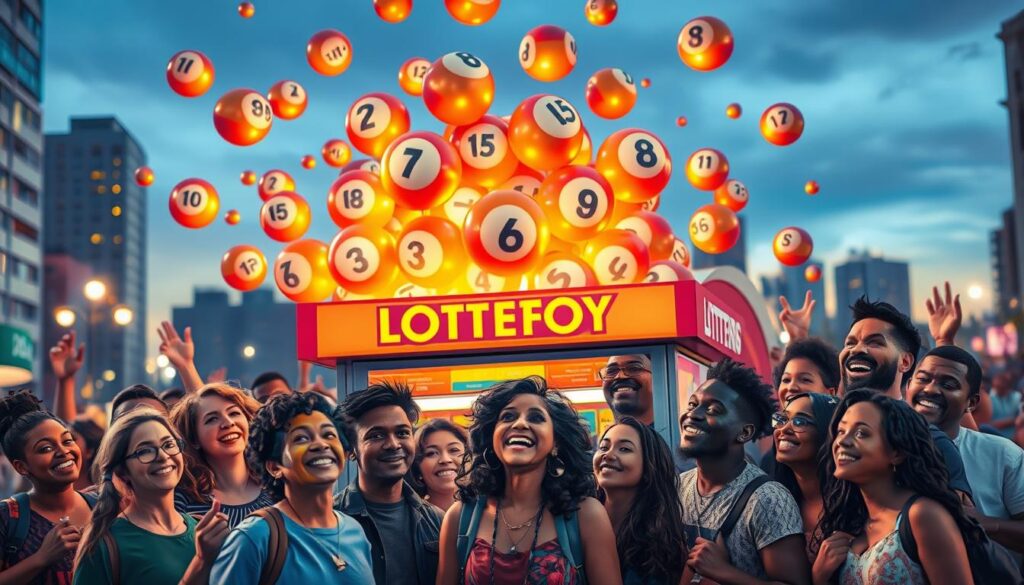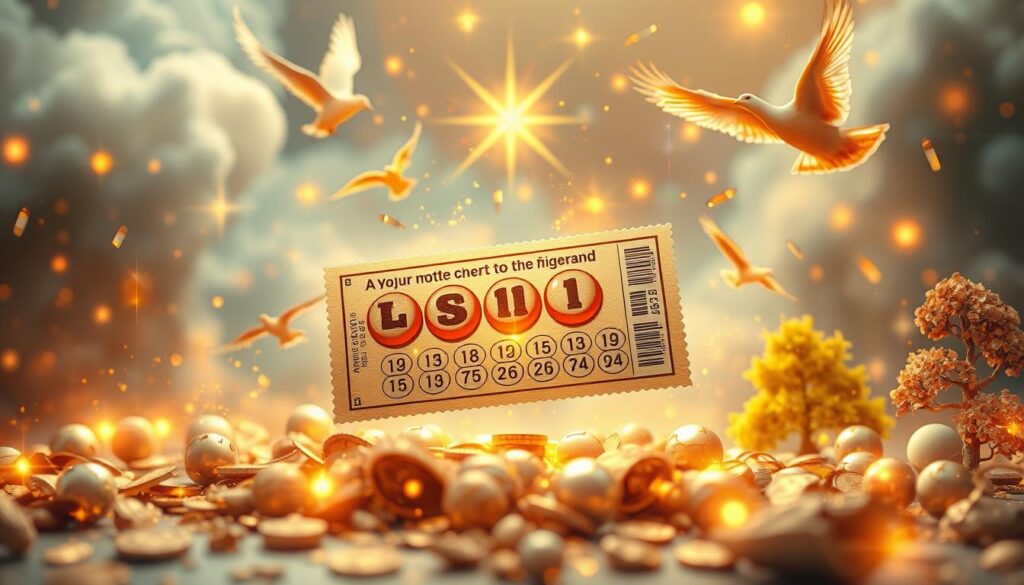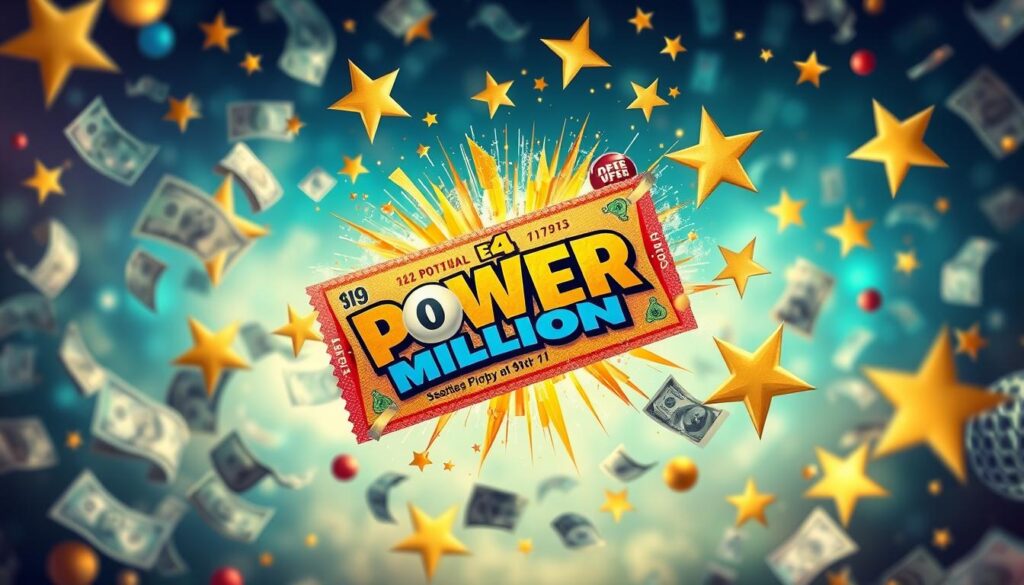We’re diving into why Powerball and Mega Millions are so popular. The odds of winning the Mega Millions grand prize are about one in 302.6 million. Still, people keep playing, dreaming of big wins. The jackpot hit a record $1.6 billion in 2018, drawing in millions.
The science behind lottery games is complex. It involves probability, social dynamics, and how we see things. This makes Powerball and Mega Millions really interesting to study.
At DEWAKOIN, we think knowing the lottery’s psychology is crucial. It helps us offer a safe, fun, and rewarding online gaming experience. We provide the latest lottery games, like Powerball and Mega Millions, with great winning chances. This way, every player has a fair shot at winning.
With online lottery platforms getting more popular, playing and winning is easier than ever. We’ll talk about the benefits and chances of playing lottery games.
Key Takeaways
- The Mega Millions jackpot reached a record high of $1.6 billion in the fall of 2018, making it one of the most significant lottery events in history.
- The odds of winning the Mega Millions grand prize are approximately one in 302.6 million, yet people continue to play, hoping to win big.
- Lottery games like Powerball and Mega Millions are a fascinating topic to study, involving probability, social dynamics, and human perception.
- Understanding the psychology behind playing the lottery is key to providing a secure, enjoyable, and rewarding online gaming experience for players.
- The rise of online lottery platforms has made it easier than ever to play and win, offering a range of benefits and opportunities for players.
Understanding the Psychology Behind Lottery Participation
The lottery’s allure stems from the psychology of lottery participation. It’s a mix of hope and anticipation. The chance to win big creates excitement and anticipation. This drives people to buy lottery tickets.
This behavior taps into human nature. People are ready to take risks for a big reward. It’s a natural part of who we are.
The risk-taking behavior in lottery play is intriguing. Despite low winning odds, people spend money on tickets. They dream of a better life and financial security.
- About 50% of US adults play the lottery every year.
- People see more value in lottery tickets when the jackpot is higher.
- Those with the lowest socioeconomic status gamble the most in lotteries.
Understanding lottery psychology helps us see why people play. Hope, anticipation, and risk-taking make the lottery appealing. It’s a popular form of entertainment worldwide.
The Numbers Game: Probability and Human Perception
The chance of winning in lottery games is key. Knowing the winning number statistics helps players make better choices. At DEWAKOIN, we aim to offer a safe and fun gaming space. We’re open about the odds of winning.
How people see probability can change based on many things. For example, winning Powerball’s jackpot is about 1 in 292.2 million. Yet, the prize can be huge. Remember, each draw is a new chance, and the odds stay the same for every ticket.
Here are some interesting lottery facts:
- Americans spend almost $100 billion on state lotteries each year.
- Powerball tickets cost $2, with extra options for bigger payouts.
- About 50% of ticket sales go to prizes, with the rest for state programs and costs.
Knowing the lottery’s numbers game helps us play smarter. At DEWAKOIN, we focus on exciting slot games with good winning chances. We want every player to have a fair shot at winning.
The Dopamine Effect: How Lottery Games Trigger Brain Chemistry
The dopamine effect is key in shaping our actions, and lottery games are a big part of it. This effect triggers brain chemistry, releasing neural rewards that push us to play lottery games.
The biology of hope also plays a big role. It builds anticipation and excitement, making us want to keep playing. When we play lottery games, our brains get a dopamine rush. This rush makes us want to play again.
Several factors contribute to the dopamine effect in lottery games. These include:
- Anticipation and excitement
- Uncertainty and unpredictability
- Hope and optimism
Together, these factors create a powerful mix. They trigger brain chemistry and release neural rewards. This makes lottery games both appealing and addictive.
Social Dynamics of Lottery Participation
Lottery games are more than just individual play. They are about the social bonds they create. About 50% of Americans have bought a lottery ticket at some point. And, about 20% of people buy most of the tickets.
Buying tickets with friends, family, or coworkers is common. This group purchasing behavior is seen in workplace pools. It brings excitement and a chance to win together. Lottery games also help local charities and projects.
Some interesting facts about lottery play include:
- 30% of those without a high school diploma see lottery play as a way to get rich.
- People earning less than $12,400 a year spend about 5% of their income on lottery tickets.
- The chance of winning any prize in Mega Millions is about 1 in 40.

In summary, the social side of lottery games is key to their appeal. Understanding how groups buy tickets and the impact on communities helps us see their value.
| Statistic | Value |
|---|---|
| Percentage of Americans who buy at least one lottery ticket | 50% |
| Percentage of population that accounts for majority of lottery ticket purchases | 20% |
| Odds of winning any prize in Mega Millions lottery | 1 in 40 |
The Fascinating Science That Drives Powerball and Mega Millions’ Popularity: A Deep Dive
People love lottery games like Powerball and Mega Millions because of their fascinating science. The chances of winning are slim, but the prizes are huge. This mix makes playing exciting.
The Powerball and Mega Millions games have become huge hits worldwide. They attract millions of players. The thrill of winning big or the fun of playing with others are big draws. These games are now a big part of our fun culture.
- The estimated Mega Millions jackpot for tonight is $1.1 billion, making it the second-largest jackpot in Mega Millions history.
- Powerball’s odds of winning the jackpot are approximately 1 in 292.2 million, while Mega Millions has slightly better odds at about 1 in 302.6 million.
- In 2022, Powerball witnessed a total of approximately $1.8 billion in sales, while Mega Millions generated around $1.4 billion in sales.
These numbers show how popular Powerball and Mega Millions are. They also highlight the fascinating science behind their success. By studying lottery games, we can learn more about human behavior and choices.
| Game | Jackpot | Odds of Winning |
|---|---|---|
| Powerball | $90 million (average) | 1 in 292.2 million |
| Mega Millions | $69 million (average) | 1 in 302.6 million |
Marketing Psychology: How Lottery Advertising Taps Into Human Desires
Marketing psychology is key to lottery games’ success. Lottery ads tap into our desires to get people to play. They use bright colors and appealing images to grab our attention and touch our hearts.
Ads often talk about the big wins to get us excited. The size of the jackpot matters a lot. Studies show that bigger jackpots draw more players. Our minds play tricks on us, like thinking we’ll win, thanks to ads.
Lottery ads use a few tricks to get us interested:
- They share stories of winners to build trust
- They promise hope and excitement through stories
- They make us feel part of a community
Understanding marketing psychology helps us see why lottery games are so popular. It’s all about our desires, what we see, and how ads work on us. As we dive deeper into lottery games, it’s important to see how these elements come together.

Economic Factors: Why People Play Despite the Odds
At DEWAKOIN, we know that economic factors are big reasons why people play lottery games. Even though the odds of winning are low, the chance for big wins is a big pull. This is true for those who feel they don’t have many chances to move up in life.
In 2021, Americans spent over $100 billion on lottery tickets. This makes it the most popular gambling activity in the country. People all over the world are drawn to the chance of winning big, even when the odds of winning are against them.
Here are some key factors that make lottery games appealing:
- About 50% of Americans buy a lottery ticket at least once a year.
- One in eight Americans buys a lottery ticket every week.
- The top 20 to 30% of lottery players make up 70 to 80% of all lottery sales in the country.
We think it’s important to understand these economic factors to see why people keep playing lottery games. Despite the low odds of winning, the chance for big wins is a big draw. We want to offer a safe, fun, and rewarding online gaming experience. We aim to give our players the best chance to win while also encouraging responsible gaming.
The Role of Media Coverage in Driving Lottery Fever
Media coverage is key in making people excited about the lottery. Social media, news, and stories of big winners add to the buzz. During big jackpot times, ticket sales can jump by up to 30%.
News and social media spark interest in lottery games. Social media makes it easy to share lottery wins and excitement. Studies show a 20% rise in players thanks to social media.
Some important stats show media’s effect on lottery fever:
- A 25% jump in ticket sales after big jackpot media campaigns
- States with more media on jackpots see a 10% or more revenue boost each year
- On average, U.S. households spend about $500 a year on lottery tickets
Media coverage greatly affects how people see and play the lottery. It shows how media, social media, and big jackpots keep lottery fever alive. This mix is why lottery excitement keeps growing across the country.
Historical Patterns of Lottery Psychology
We’ve been exploring the world of lottery psychology. Now, let’s look at the historical patterns that shape how people play the lottery. These patterns help us understand why people keep playing, even with low odds.
Lottery psychology has changed a lot over time. From the start of lottery games to now, historical patterns have shaped how we think about and play the lottery. For instance, new technologies have made playing easier and more accessible.
Some important historical patterns in lottery psychology include:
- The rise of lottery games as a form of entertainment
- The impact of technological advancements on the lottery experience
- The influence of human behavior on lottery participation
By studying these historical patterns, we can understand what drives people to play the lottery. It could be the excitement of winning, playing with friends, or hoping to change their luck. Lottery psychology is a complex field that keeps us interested and curious.
Conclusion: The Enduring Appeal of Dream-Chasing Through Lottery Games
The lasting charm of lottery games comes from a mix of psychology, probability, and social interaction. Despite the huge odds of winning big, many in the United States still dream of a life-changing win.
Lottery games capture our hopes and the thrill of taking risks. They spark our imagination with “what if” scenarios. The excitement of almost winning and sharing dreams with others makes these games so appealing.
As Powerball and Mega Millions jackpots grow, so does their allure. Over 60% of American adults have tried their luck. This shows how much people value the chance to win big, a testament to our dreams and aspirations.
FAQ
What is the fascinating science behind the popularity of Powerball and Mega Millions?
The science behind Powerball and Mega Millions is complex. It involves psychology, probability, and how people interact. We look at the history of lotteries and why people play. It’s about understanding the odds and what makes people keep playing.
What is the psychology behind lottery participation?
Lottery psychology is about human behavior and what motivates us. It’s about hope, risk-taking, and the “what if” feeling. This helps us see why people keep playing, even with low chances of winning.
What is the role of probability and human perception in the numbers game of lottery games?
Probability and perception are key to understanding lottery odds. We look at winning number statistics and how people see probability. This helps us make sense of the lottery and the thrill of winning.
How does the dopamine effect drive the appeal of lottery games?
The dopamine effect is a big reason people love lottery games. It’s about how games affect our brain chemistry. We explore the excitement and hope that comes with playing. This shows why people keep coming back for more.
What is the role of social dynamics in the popularity of lottery games?
Social dynamics are crucial in lottery games. We look at how groups play together and the impact on communities. This shows how social aspects make lottery games popular.
What are the key insights from the deep dive into the science behind Powerball and Mega Millions?
Our deep dive covers Powerball and Mega Millions’ history and odds. We also explore why people play, despite the odds. It’s about understanding the appeal of these games.
How does marketing psychology influence the appeal of lottery games?
Marketing psychology is key to lottery games’ success. We see how ads tap into human desires. This includes visual and language tricks that make games appealing.
What are the economic factors that contribute to the popularity of lottery games?
Economic factors are important in lottery play. We look at the potential for big wins and why people take risks. It’s about understanding the allure of lottery games.
How does media coverage influence the appeal of lottery games?
Media coverage boosts lottery excitement. We examine social media, news, and celebrity wins. It shows how media shapes public opinion and draws people in.
What can we learn from historical patterns of lottery psychology?
Historical lottery psychology offers insights into human behavior. We explore the history of lotteries and how they’ve evolved. It helps us understand why people keep playing.
